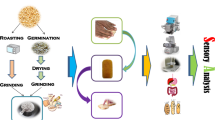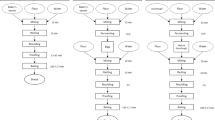Abstract
The objective of this study was to assess the contribution of transglutaminase (TG) and vital gluten (VG), alone or in conjunction, in preserving the quality of bread during storage (0, 3 and 9 days). The experimental design was set up to identify the best formulation to reduce changes in texture attributes and moisture content based on different levels of TG (0, 0.05, 0.1, 0.2 g/100 g flour), VG (0 and 1 g/100 g flour), and wheat flour strength (FS: weak—WF, medium—MF, strong—SF). Results revealed that, in most cases, TG and VG addition had a beneficial effect on preserving crumb moistness over storage. Likewise, TG and VG were able to reduce changes in textural attributes during storage. The best formulations to improve bread quality in storage were 0.1% TG and 1% VG for WF, 0.2% TG for MF and 0.2% TG and 1% VG for SF.

Similar content being viewed by others
References
Bhise S, Kaur A (2014) Baking quality, sensory properties and shelf life of bread with polyols. J Food Sci Technol 51:2054–2061. https://doi.org/10.1007/s13197-014-1256-3
Gray JA, Bemiller JN (2003) Bread staling: molecular basis and control. Compr Rev Food Sci Food Saf 2:1–21. https://doi.org/10.1111/j.1541-4337.2003.tb00011.x
Vittadini E, Vodovotz Y (2003) Changes in the physicochemical properties of wheat- and soy-containing breads during storage as studied by thermal analyses. J Food Sci 68:2022–2027. https://doi.org/10.1111/j.1365-2621.2003.tb07012.x
Curti E, Carini E, Vittadini E (2017) Staling and water dynamics in high-gluten bread. Eur Food Res Technol 243:1173–1182. https://doi.org/10.1007/s00217-016-2832-8
Fadda C, Sanguinetti AM, Del Caro A et al (2014) Bread staling: updating the view. Compr Rev Food Sci Food Saf 13:473–492. https://doi.org/10.1111/1541-4337.12064
Vodovotz Y, Hallberg L, Chinachoti P (1996) Effect of aging and drying on thermomechanical properties of white bread as characterized by dynamic mechanical analysis (DMA) and differential scanning calorimetry (DSC). Cereal Chem 73(2):264–270
Slade L, Levine H, Reid DS (1991) Beyond water activity: recent advances based on an alternative approach to the assessment of food quality and safety. Crit Rev Food Sci Nutr 30:115–360. https://doi.org/10.1080/10408399109527543
Baik M-Y, Chinachoti P (2000) Moisture redistribution and phase transitions during bread staling. Cereal Chem J 77:484–488. https://doi.org/10.1094/CCHEM.2000.77.4.484
Aguirre JF, Osella CA, Carrara CR et al (2011) Effect of storage temperature on starch retrogradation of bread staling. Starch Stärke 63:587–593. https://doi.org/10.1002/star.201100023
Imberty A, Perez S (1988) A revisit to the three-dimensional structure of B-type starch. Biopolymers 27:1205–1221. https://doi.org/10.1002/bip.360270803
Sadowska J, Błaszczak W, Fornal J et al (2003) Changes of wheat dough and bread quality and structure as a result of germinated pea flour addition. Eur Food Res Technol 216:46–50. https://doi.org/10.1007/s00217-002-0617-8
Curti E, Carini E, Tribuzio G, Vittadini E (2014) Bread staling: effect of gluten on physico-chemical properties and molecular mobility. LWT Food Sci Technol 59:418–425. https://doi.org/10.1016/J.LWT.2014.04.057
Storck CR, da Rosa Zavareze E, Gularte MA et al (2013) Protein enrichment and its effects on gluten-free bread characteristics. LWT Food Sci Technol 53:346–354. https://doi.org/10.1016/j.lwt.2013.02.005
Dizlek H, Özer MS (2016) The improvement of bread characteristics of sunn pest (Eurygaster integriceps) damaged bread wheat by blending application and using additives. Qual Assur Saf Crop Foods 8:427–437. https://doi.org/10.3920/QAS2015.0719
Schoenlechner R, Szatmari M, Bagdi A, Tömösközi S (2013) Optimisation of bread quality produced from wheat and proso millet (Panicum miliaceum L.) by adding emulsifiers, transglutaminase and xylanase. LWT Food Sci Technol 51:361–366. https://doi.org/10.1016/j.lwt.2012.10.020
Basman A, Koksel H, Ng PKW (2002) Effects of transglutaminase on SDS-PAGE patterns of wheat, soy, and barley proteins and their blends. J Food Sci 67:2654–2658. https://doi.org/10.1111/j.1365-2621.2002.tb08794.x
Renzetti S, Behr J, Vogel RF, Arendt EK (2008) Transglutaminase polymerisation of buckwheat (Fagopyrum esculentum Moench) proteins. J Cereal Sci 48:747–754. https://doi.org/10.1016/j.jcs.2008.04.005
Bardini G, Boukid F, Carini E et al (2018) Enhancing dough-making rheological performance of wheat flour by transglutaminase and vital gluten supplementation. LWT Food Sci Technol. https://doi.org/10.1016/j.lwt.2018.01.077
Ortolan F, Corrêa GP, da Cunha RL, Steel CJ (2017) Rheological properties of vital wheat glutens with water or sodium chloride. LWT Food Sci Technol 79:647–654. https://doi.org/10.1016/J.LWT.2017.01.059
Giannou V, Tzia C (2007) Frozen dough bread: quality and textural behavior during prolonged storage—prediction of final product characteristics. J Food Eng 79:929–934. https://doi.org/10.1016/j.jfoodeng.2006.03.013
Ortolan F, Steel CJ (2017) Protein characteristics that affect the quality of vital wheat gluten to be used in baking: a review. Compr Rev Food Sci Food Saf 16:369–381. https://doi.org/10.1111/1541-4337.12259
Boukid F, Carini E, Curti E et al (2018) Effectiveness of vital gluten and transglutaminase in the improvement of physico-chemical properties of fresh bread. LWT Food Sci Technol. https://doi.org/10.1016/j.lwt.2018.02.059
AACC International (2001) AACC International approved methods of analysis. AACC International, Cambridge
Alvarez M, Canet W, López M (2002) Influence of deformation rate and degree of compression on textural parameters of potato and apple tissues in texture profile analysis. Eur Food Res Technol 215:13–20. https://doi.org/10.1007/s00217-002-0515-0
Basman A, Köksel H, Ng P (2002) Effects of increasing levels of transglutaminase on the rheological properties and bread quality characteristics of two wheat flours. Eur Food Res Technol 215:419–424. https://doi.org/10.1007/s00217-002-0573-3
Gujral HS, Rosell CM (2004) Functionality of rice flour modified with a microbial transglutaminase. J Cereal Sci 39:225–230. https://doi.org/10.1016/j.jcs.2003.10.004
Collar C, Rosell C (2013) Relationship between the mixolab and other devices. Mixolab. https://doi.org/10.1016/B978-1-891127-77-9.50007-8
Callejo MJ, Gil MJ, Rodríguez G, Ruiz MV (1999) Effect of gluten addition and storage time on white pan bread quality: instrumental evaluation. Zeitschrift fur Leb-forsch A 208:27–32. https://doi.org/10.1007/s002170050370
Rosell CM, Wang J, Aja S et al (2003) Wheat flour proteins as affected by transglutaminase and glucose oxidase. Cereal Chem J 80:52–55. https://doi.org/10.1094/CCHEM.2003.80.1.52
Mujoo R, Ng PKW (2003) Identification of wheat protein components involved in polymer formation on incubation with transglutaminase. Cereal Chem J 80:703–706. https://doi.org/10.1094/CCHEM.2003.80.6.703
Acknowledgements
The authors would like to thank Gloria Bardini for carrying out a part of data acquisition.
Author information
Authors and Affiliations
Corresponding author
Ethics declarations
Conflict of interest
The authors declare that they have no competing interest.
Compliance with ethics requirements
During research no human participants and animals were involved.
Additional information
Publisher’s Note
Springer Nature remains neutral with regard to jurisdictional claims in published maps and institutional affiliations.
Rights and permissions
About this article
Cite this article
Boukid, F., Carini, E., Curti, E. et al. Bread staling: understanding the effects of transglutaminase and vital gluten supplementation on crumb moisture and texture using multivariate analysis. Eur Food Res Technol 245, 1337–1345 (2019). https://doi.org/10.1007/s00217-019-03256-6
Received:
Accepted:
Published:
Issue Date:
DOI: https://doi.org/10.1007/s00217-019-03256-6




